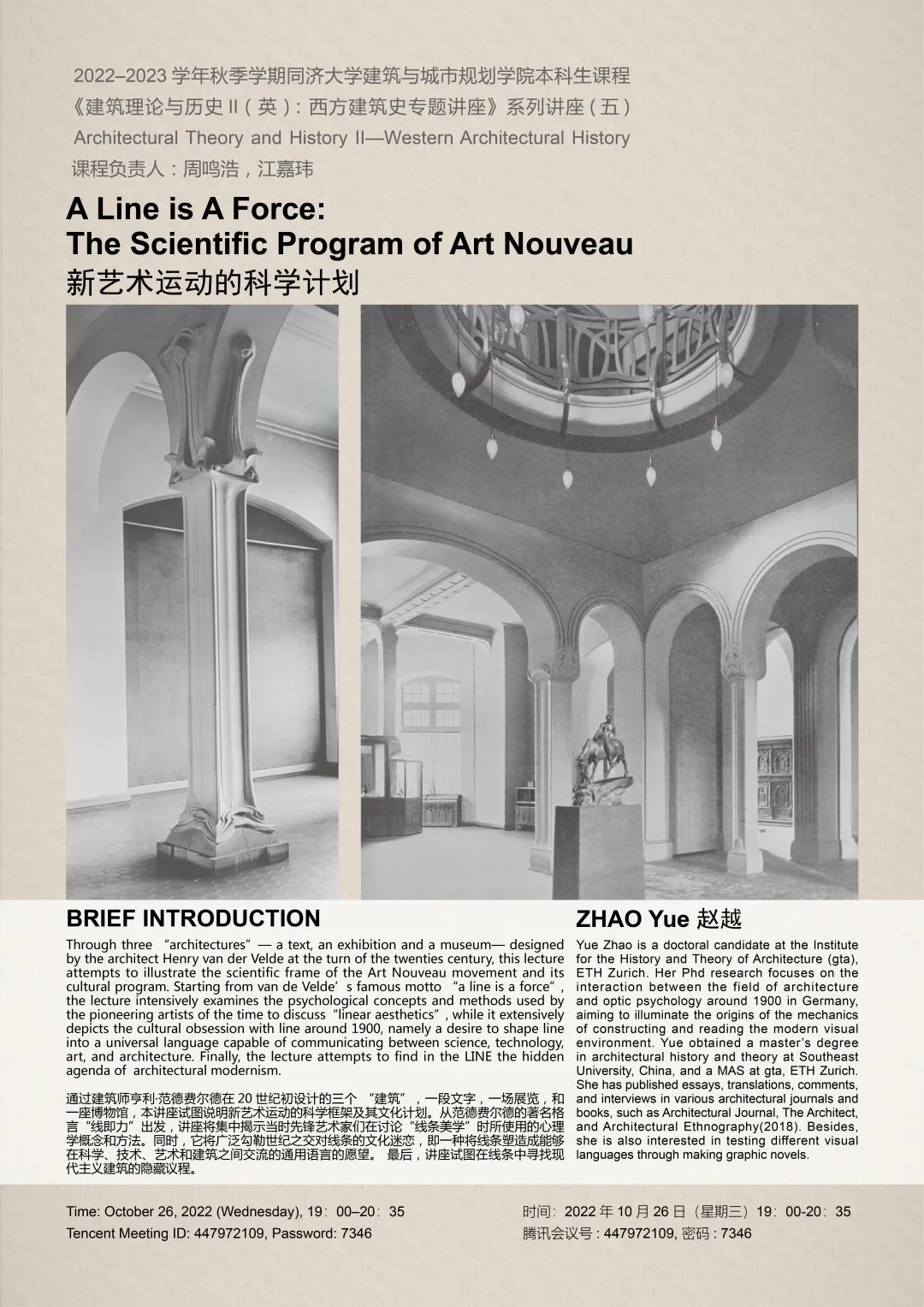
Lecture

A Line is A Force: The Scientific Program of Art Nouveau
Speaker:ZHAO Yue
Time: October 26, 2022 (Wednesday), 19:00–20:35
Tencent Meeting ID: 447972109, Password: 7346
Brief Introduction
Through three “architectures”—a text, an exhibition and a museum— designed by the architect Henry van der Velde at the turn of the twenties century, this lecture attempts to illustrate the scientific frame of the Art Nouveau movement and its cultural program. Starting from van de Velde’s famous motto “a line is a force”, the lecture intensively examines the psychological concepts and methods used by the pioneering artists of the time to discuss“linear aesthetics”, while it extensively depicts the cultural obsession with line around 1900, namely a desire to shape line into a universal language capable of communicating between science, technology, art, and architecture. Finally, the lecture attempts to find in the LINE the hidden agenda of architectural modernism.
Speaker Information
Yue Zhao is a doctoral candidate at the Institute for the History and Theory of Architecture (gta), ETH Zurich. Her Phd research focuses on the interaction between the field of architecture and optic psychology around 1900 in Germany, aiming to illuminate the origins of the mechanics of constructing and reading the modern visual environment. Yue obtained a master’s degree in architectural history and theory at Southeast University, China, and a MAS at gta, ETH Zurich. She has published essays, translations, comments, and interviews in various architectural journals and books, such as Architectural Journal, The Architect, and Architectural Ethnography(2018). Besides, she is also interested in testing different visual languages through making graphic novels.
References:
1. Henry van de Velde, “Prinzipielle Erklärungen”, Kunstgewerbliche Laienpredigten, Leipzig: Hermann Seemann Nachfolger, 1902.
2. Linie und Form: Erläut. Verzeichnis der Ausstellung formenschöner Erzeugnisse der Natur, Kunst und Technik im Kaiser-Wilhelm-Museum zu Krefeld, April und Mai 1904, Krefeld: Kramer & Baum, 1904.
Secondary literature
3. Katherine M. Kuenzli, Henry Van de Velde: Designing Modernism, New Haven/London: Yale
University Press, 2019.
4. Estelle Thibault. “Constructing Emotions. The Scientific Aesthetics of Architecture in France 1860–1900.” Bressani, Martin; Contandriopoulos, Christina. The Companions to the History of Architecture, Volume III, John Wiley & Sons, 2017: 432-447.
5. M. Norton Wise, Neo-Classical Aesthetics of Art and Science: Hermann Helmholtz and the Frog-Drawing Machine, the Hans Rausing Lecture 2007, Uppsala university, 2008.
6. David Morgan, “The Idea of Abstraction in German Theories of the Ornament from Kant to
Kandinsky,” The Journal of Aesthetics and Art Criticism, Vol. 50, No. 3 (Summer, 1992): 231-242.
POST:
Pillars in entrance hall and exhibition room of the Folkwang Museum, Hagen, Germany, designed by Henry van de Velde in 1902 © Bildarchiv Foto Marburg / Photo: unknown; Rec. date: 1906/1940.
 ABOUT US
ABOUT US




